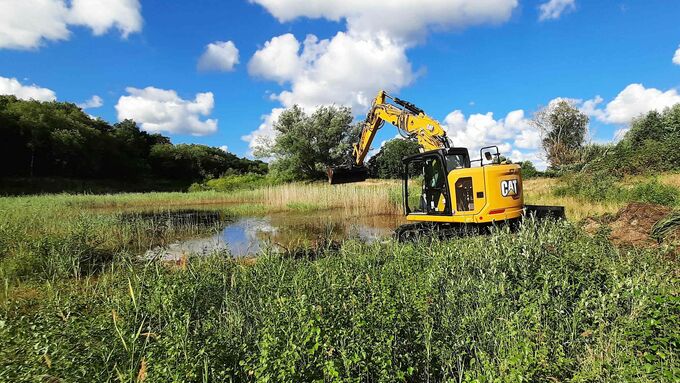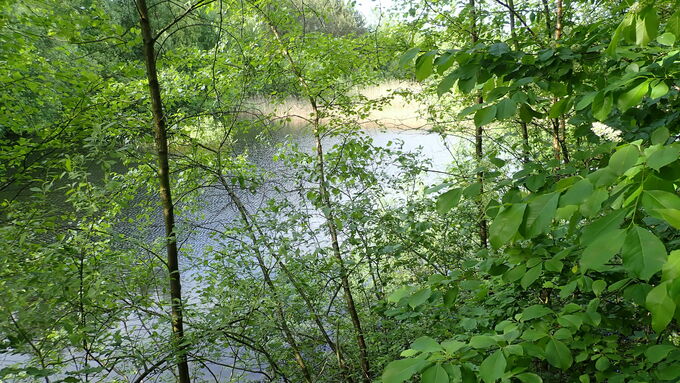In September 2022, the excavator could finally get going and start optimizing the waterbodies. © Michael Steven, ÖNSOF
download picturemain content
Project of the month
#10/2022 AMPHIBIAN BIOTOPE BROCKZETEL (DISTRICT OF AURICH)
Light shallow water zones instead of dark undergrowth
Experts were already aware of the sand quarry as an important amphibian habitat in the 1980s. The local population became aware of the pit near Brockzetel in the district of Aurich due to the large migratory movements along the nearby road and the subsequent annual erection of an amphibian protection fence. In the vernacular, it is therefore known as the ‘toad pit’. The 5.5-hectare ‘Amphibian Biotope Brockzetel’ has been officially protected as a natural monument since 1986.
Especially common toads (Bufo bufo), grass frogs (Rana temporaria), common newts (Lissotriton vulgaris) and green frogs (Pelophylax sp.) are attracted to the waterbodies in the sand pit. The ponds are generally also suitable for the common spadefoot (Pelobates fuscus), but recently this species has only been recorded in the surrounding area on the nearby military training ground.
The ecologically diverse natural monument also has a lot to offer in botanical terms; especially rare species of the nutrient-poor sandy waterbodies such as shoreweed (Littorella uniflora), pillwort (Pilularia globulifera), allseed (Radiola linoides), marsh clubmoss (Lycopodiella inundata) and the carnivorous sundew (Drosera sp.) could be discovered here with a trained eye. The southern marsh orchid (Dactylorhiza praetermissa), one of the native orchid species, is also found here.
Without human intervention, however, the pit became more and more overgrown. Woody plants shaded the littoral zones where the rare plant species used to grow. They were only able to survive in small areas that remained open. Invasive neophytes - non-native plant species that displace the local flora - also found their way into the toad pit: the giant hogweed (Heracleum mantegazzianum) proliferated, sometimes explosively, and the Japanese knotweed (Fallopia japonica) also formed dense stands so that other species no longer had a chance.
The prospects for the common spadefoot, one of the focus species of the LIFE IP, also deteriorated, so that the Ökologische NABU-Station Ostfriesland (NABU Ecological Station East Friesland, ÖNSOF) submitted an action in the framework of the project at the end of 2018. Concerned about the situation of the natural monument, ÖNSOF and the district of Aurich jointly took up the chainsaw in 2018. But bigger equipment was needed: In 2020, an excavator started to work as part of the LIFE IP to clear the waterbodies of woody plants. After this, light fell on the waterbodies again and more burrowable soil was revealed. Not only sand-loving insects are pleased about this, but also the common spadefoot which likes to dig in during the day to hide from enemies.
Before the littoral zones could be optimized, however, an investigation of the potentially existing contaminations from construction waste from the 1970s had to be carried out at short notice. A risk assessment was made to rule out harmful soil and groundwater contamination. In the end, the final report was available and gave the green light: No pollutants leaked out, so that the earthworks could be completed in September 2022. In the process, shallow water zones were created for the special pond community and the common spadefoot in particular. By scraping off a layer of mud, vegetation-free bank areas were promoted and the reeds reduced. On a sandy elevation, the excavator removed the litter layer of a former pine plantation and optimised a steep face as a nesting biotope for sand martins (Riparia riparia).
The action also included the preparation of the future fence route for maintenance grazing. Since 2021, the pit has been grazed by goats which busily nibble away the resprouting woody plants, Japanese knotweed and even the giant hogweed three times a year for a few weeks. In this way, the open character of the amphibian biotope with its valuable sandy open soil patches can be preserved in the coming years. The wolf-proof fence was financed by the district of Aurich. The grazing which is also financed by the district is carried out under a maintenance contract with a landscape management company.





